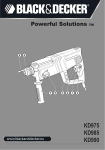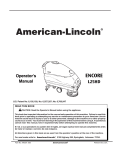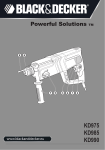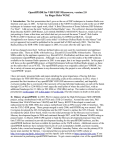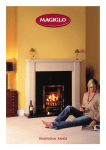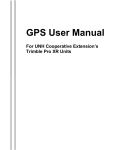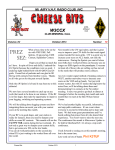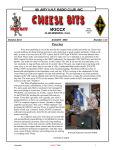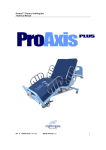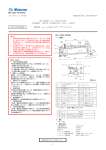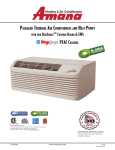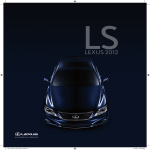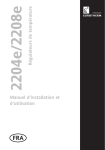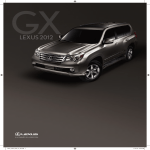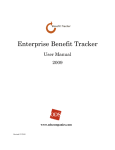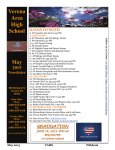Download 1 A User`s View of the DSP-10: Bob Larkin W7PUA`s
Transcript
A User's View of the DSP-10: Bob Larkin W7PUA’s Innovative 144 MHz DSP Transceiver --by Roger Rehr, W3SZ I. Overview The DSP-10 is a dedicated 2-meter amateur radio 'weak signal' multimode transceiver designed by Bob Larkin, W7PUA. Bob's description of this hardware/software combination and the schematic diagrams and notes necessary to build it from scratch were contained in QST magazine for September, October, and November, 19991. This 'software defined radio' is more than a signal processor. It provides not only signal processing, and the traditional CW, SSB, and FM modes, but also entirely new digital modes of communication using long-term integration and FSK techniques that allow communications at signal levels that would be impossibly low with standard techniques. The DSP-10 is different from Linrad2 3, Spectran, Hamview, DSPBlaster, and other 'familiar' signal processing software in several ways4. First, the DSP-10 is a complete transceiver, with all the hardware necessary to receive and generate signals in the 144 MHz Amateur band. Secondly, the DSP-10 uses an Analog Devices EZ-Kit Lite to do the DSP processing rather than a sound card; it connects to a PC via a serial port and just makes use of the PC for control and display; the EZ-Kit Lite does all of the computational chores. The DSP-10 software can also be used without the RF hardware, as an audio DSP processor, using just the Analog Devices EZ-Kit Lite evaluation board (see below). Or, it can be used with an external homebrew front-end, functioning as the final IF of a homebrew receiver. I have done this at W3SZ with just a couple of TUF-1H’s and computer-controlled oscillators to make a very nice receiver that covers from below the AM Broadcast band to the 432 MHz band. The hardware I used with the DSP-10 software in this manner was very similar to what I use with Linrad5. II. DSP-10 Display and Software Features Whether used with or without the DSP-10 RF hardware, Bob's DSP-10 software has an excellent waterfall display with adjustable gain, adjustable baseline, and adjustable signal averaging (see Figure 1). The palette of waterfall colors can be adjusted as well, but unlike the other parameters discussed here, which can be changed on the fly while operating by typing a few keystrokes, changing the palette requires changing the configuration file. The visualized bandwidth can be set to 1200, 2400 or 4800 Hz. The DSP-10 software has an excellent spectral display, also with adjustable gain, adjustable baseline, adjustable signal averaging, and 1200, 2400 or 4800 Hz visualized bandwidth. In Figure 1 you can see the spectral display at the top right of the display, with the waterfall display below. These displays share the same frequency calibration. At the time this snapshot was taken, the DSP-10 was receiving a CW beacon at 144.284070 MHz. You can see that the spectral width of the display is 2400 Hz for this example, and that the beacon is about 40 dB above the noise floor. Although the spectral scale is set for 10 dB per division here, this can be changed to 5, 2, or 1 dB per division if desired. You can see a cursor at the top of the signal peak produced by the beacon. This cursor automatically follows the maximum signal detected within the display range, and the level of this signal is displayed as 'Signal Level' in dBm just beneath the main frequency readout and the horizontal bar graph of signal strength on the upper left portion of the screen. Beneath the 'Signal Level' indication is the frequency of the automatically detected peak signal, in Hz. This value corresponds to the frequency calibration markers for the spectral and waterfall displays. Below the waterfall display are indicators for the relative signal levels of both the A/D and the D/A converters, and at the lower right corner on the same line the signal strength displayed (35.32 dB) represents the average power level of the 1 spectral display. This bottom line of the display can be changed to show the DSP status data, Moon data (Azimuth, Elevation, Doppler shift, and relative signal level), Sun data (Azimuth and Elevation), or left blank if desired. On the left of the screen, below the frequency readout and signal level indicators are some of the user-defined parameters, which can be set as noted above with various keystroke combinations which are for the most part intuitive and easily learned. In addition, a command summary sheet is available from W7CQ and KO7N’s website at http://home.teleport.com/~oldaker/dsp10_repository.htm. These user-adjustable parameters include the contrast and brightness of the waterfall display, microphone gain, CW speed (for transmit only), transmit power, and mode. When the mode is CW, the first number displayed to the right of 'Mode' represents the amplitude of the CW sidetone, and the second number represents the frequency of the CW offset. The frequency of the CW sidetone tracks the frequency of the CW offset. Modes currently implemented include CW, SSB (USB and LSB), FM, and four 'new' modes LHL7, PUA43, EME2, and LTI that will be discussed in a section below. Below this are the values of the RIT, a designation of what audio filter is selected, the status of the LMS denoiser, and the status of the binaural delay. The DSP-10's DSP audio processing provides 200, 300, and 450 Hz bandwidth filters at center frequency of 600 Hz, a 600 Hz bandwidth filter at center frequency of 700 Hz, and a 300 Hz bandwidth filter at a center frequency of 800 Hz. In addition there are a sin(f)/f matched filter for 12 wpm CW, two SSB filters (250 to 2500 Hz and 200 to 2900 Hz), and a design-your-own filter too. The LMS noise reduction can be activated and its adaptation gain adjusted with a couple of keystrokes. The decay rate and the delay line length, which are less likely to need adjustment, are adjustable from within the configuration file. The LMS auto-notch can be activated or defeated with a few keystrokes. Unfortunately the automatic notch filter frequency is not manually adjustable, so it will very effectively eliminate the desired CW signals when activated. The final parameter displays in this screen column are for the number of spectral averages per displayed point, the type of windowing function (none, Tukey25, Hamming, or BH-92), AF and RF receive gain, ACG status and level, and Automatic Display Correction (essentially AGC for the waterfall display). Much more information regarding the capabilities and operation of the DSP-10 software is available from Bob Larkin's we bsite, the URL of which is given below. Once on that web page, go to the section titled “Version 3.0 Software” and click on the “User’s Manual” link for this information. III. Getting Started The DSP-10 software is free and can be downloaded from Bob Larkin's web site at http://www.proaxis.com/~boblark/dsp10.htm. As this is written, the current version of the software is 3.0. It runs only under true DOS mode and does not run in a DOS Window. Bob’s web site has a wealth of information regarding the DSP-10 including but not limited to pdf file copies of the original QST articles, a link to the Analog Devices web page (they make the EZ-Kit Lite and it can be purchased from their website), a parts list that makes ordering the parts for the project a simple matter, an assembly manual with numerous helpful hints, the most recent version of the software, corrections and improvements to previous documents, and links to web pages with diagnostics software and hints on how to get the DSP-10 up and running in best form. Bob and KD7TS have also placed an excellent user’s manual for Version 3.0 of the software at http://members.ispwest.com/kd7ts/ver3/Man2.html. Although I built my first DSP-10 by individually ordering parts based upon the information on Bob's website and found oding so to be straightforward, I subsequently purchased two DSP-10 kits from TAPR (http://www.tapr.org). TAPR has periodically made kits available with all parts included except for the EZ-Kit Lite, and this further simplifies the parts procurement process and reduces costs thru economies of scale. 2 Check their website for details on the next kit run. Unfortunately, the EZ-Kit Lite, originally Analog Devices Part ADDS-21XX-EZLITE, is now part number ADDS-2181-EZLITE, and the price has risen several fold. I purchased mine from Newark Electronics in 1999 and then again in early 2001, when the price was $94.70. As of 02/15/2003 the board can be purchased directly from Analog Devices for $245.00 plus shipping, or from Newark Electronics for $346.95 plus shipping, as well as from other vendors. Recently several amateur-designed alternatives to the EZ-Kit Lite have begun to surface. Peter Rhodes, G3XJP, has designed the PIC-A-STAR, which is an HF transceiver based on the EZ-Kit Lite. As a part of this project he has designed and built a homebrew replacement for the EZ-Kit Lite that would be suitable for use with the DSP-10 with a few changes to the DSP-10 software. Bob Larkin has indicated that he plans to make the necessary software changes, and Bob does not anticipate any problems with this approach. Peter's PIC -A-STAR design has been running in RadCom for the last 7 months6, and is about 1/3 of the way through, according to Peter. The article includes the PCB artwork, components lists, schematics, etc., as well as a description of how to complete the construction with just 'domestic kitchen resources', as Peter puts it.Lyle Johnson, KK7P, is also putting together a DSP module that may replace the EZ-Kit Lite. Details will be on his web page7. Finally, DH6IAL and DC9UP are also working on a substitute for the EZ-Kit Lite. They will post an announcement to the DSP-10 mailing list when details are finalized. Details should also appear on the webpage http://www.walter-schroeer.de. Setting up the audio version of the DSP-10, without the RF hardware, is a piece of cake. You just plug the audio output of your rig into the input of the EZLITE, plug your headphones into the output of the EZLITE, connect a serial cable from your computer to the EZLITE, and fire up the software. It’s just as easy as this if you are using your own external RF front-end instead of a commercial rig. Building the complete DSP-10 computer-controlled 144 MHz transceiver as described in the September, October, and November 1999 issues of QST takes some time but it is not difficult, although the design does make use of surface mount technology. I built a DSP10 144 MHz transceiver in early 2000 and have found it to be superb as a microwave IF. The ability to spot those weak signals that are up to 4 kHz off frequency at 2304 MHz and above is critical in the microwave contests, and this radio really does that superbly. I have also used the DSP-10 144 MHz transceiver as a 144 MHz weak signal receiver, and I have used it on 144 MHz EME. For weak signal 144 MHz terrestrial use in a noisy urban location its somewhat limited dynamic range is at times problematic, as it can be overloaded when there are strong local signals present. The ARRL lab rated its IP3 at -21 dBm. The limitation in dynamic range is I think probably a reflection of the limited dynamic range of the EZLITE. The EZLITE is based on the ADSP-2100 Series of DSP Microcomputers. These are 16 bit fixed-point processors, and the Codec used in the EZLITE is the AD1847 which has probably just 12-13 bits of usable dynamic range although it is a 16 bit device. I believe the dynamic range limitation is in these components and not in the analog RF front end. The DSP-10 uses a MAR-6 as the first RF amplifier, and this device has an IP3 of +14 dBm. Although it is followed by a MAR-3 before the first TUF-1 Mixer and the crystal filter, I don’t think these analog components are the factor limiting dynamic range. IV. DSP-10 Hardware The DSP-10 144 MHz transceiver hardware is described in detail in the original QST articles. 8 This information is also available on Bob Larkin's web site , and also on the CD that is a part of 9 the ARRL publication Experimental Methods in RF Design . The text of the latter publication discusses in some detail the rudiments of the DSP-10 software, as well. The basic hardware design is that of a dual conversion receiver, with the first LO at 124.3 to 128.4 MHz, giving a 3 first IF of 19.665 MHz, and the second LO at 19.680 MHz, giving a second IF of 15 KHz which is then coupled to the EZ-Kit Lite for DSP signal processing. Coarse 5 KHz tuning steps are provided by the first LO synthesizer, and fine 1 Hz steps are provided by the DSP software. The DSP software uses quadrature mixing for SSB and an arc tangent detector for FM. The DSP-10 communicates with the DOS PC via a serial port operating at 9600 baud. The signal path from the antenna and a block diagram of the hardware are shown in Figure 2. The received signal coming from the antenna sees a PIN diode T/R switch, and then a 143-149 MHz bandpass filter. RF amplification is then provided by MAR-6 and MAR-3 MMIC's, as noted above. Another PIN diode T/R switch is then followed by a Cohn-type 143-149 MHz bandpass filter. This is followed by the TUF-1 first mixer, which is in turn followed by a fourpole 19.665 MHz crystal filter and then the second mixer, also a TUF-1. This is followed by a low-pass filter with a cutoff of around 28 KHz, and then a low noise amplifier before the signal is sent to the EZ-Kit Lite. All further processing occurs on this DSP board. For transmit, the signal path is essentially reversed. The EZ-Kit Lite generates the signal at a frequency of 15 KHz. This is then amplified and after passing through a T/R switch is mixed with the second LO at the second mixer to generate a 19.665 MHz signal, which passes through the four-pole 19.665 crystal filter and is converted to 144 MHz at the first mixer. The transmit signal is then passed through the Cohn bandpass filter, amplified by a MAR-6 and then a MAR-4 and then a 2N5109. It is finally low-pass filtered, and then passes thru the T/R switch adjacent to the antenna connector. The DSP-10 144 MHz Transceiver requires 13.6 V at 0.75 A maximum (operating voltage range is 10.6-16 V). It covers 144-148 MHz. The receiver noise floor as measured by the ARRL lab with 450 Hz filter is -136.8 dBm. The second-order intercept point with 66 and 72 MHz inputs is +69 dBm. The third-order intercept point (IP3), as noted above, is -21 dBm. IF rejection is 127 dB, and image rejection is 125 dB. Maximum output power is 40 mW. These and other specifications are given in the final DSP-10 QST article from November, 1999. The June, 2000 issue of QST contains another article by W7PUA describing the construction of an amplifier that increases the power of the DSP-10 to 8 watts10. V. Practical Experience with the DSP-10 Before describing the very original and unique automated detection and decoding features of the DSP-10 I’d like to share my experiences using it for CW operation during the September 2000 Italian EME Contest. The equipment setup I used for these tests was as follows. The antenna system was a 2 x 2 stack of M2 2MXP20's with separate receive lines for Horizontal and Vertical Polarity. There were dual ARR 144 MHz preamps on the tower, close to the power dividers. The feed lines (LMR600UF to the bottom of the tower, and then 7/8 inch hardline to the operating position) were connected to an EME grade relay in the shack so I could switch polarity with a flick of a switch, or monitor both H and V on two different receivers. For the receiver comparison testing I kept this relay in place, and hooked a two way power divider after it to split the receive signal into two paths, one path to the SSB Electronics LT2S Mk II / K2 combination, and one to the RF version of the DSP-10. Because I have more than 20 dB of preamp gain on the tower, and significantly less feedline loss than this, this signal splitting didn't produce any noticeable signal degradation. I had the audio from both combinations fed into a professional audio mixer (Sampson) with good RF shielding, and then fed the output from the mixer into a computer running DSP Blaster, directly to another set of headphones, and also to another computer running Spectran for visual assessment of the received signal (spectrum and waterfall displays). 4 What I found during the Italian EME contest was that I found stations more easily and I found listening to them and copying them more comfortable on the DSP-10 hardware than with my SSB Electronics LT2S Mk II / Elecraft K2 combination, whether I was running the LT2S/K2 with no DSP, with DSP-blaster, with the AUDIO version of DSP-10, or with Spectran. I think this relates primarily to the fact that the implementation of binaural receive on the DSP-10 is superb. There were signals I essentially couldn't appreciate with the binaural mode deactivated on the DSP-10, that just popped out of the background noise when I turned it on (I normally run with it on, and turned it off just to try to figure out why the DSP-10 receiver seemed so 'hot', so what actually happened was that signals that were easy copy became lost in the mud when I turned off the binaural). Also, the quality of the signal when received through the DSP-10 144 MHz transceiver just seems better than when the audio DSP-10 is tacked onto the end of the audio chain after the Elecraft K2. Thirdly, the very slow tuning rate of the DSP-10 (10 Hz at a time by keystroke, not with an infinitesimal rotation of a knob) was a real advantage with the weak signals, especially since they could be seen on the display and 'dialed in' using the computer keyboard until they were centered at 600 Hz on the screen, right at the center of the DSP filter. Finally, I think the mast mounted preamps likely eliminated any effect of the better MDS the transverter/K2 combination might have compared with the DSP-10, and evened the score in this regard. I had previously compared the K2 with the IC-735 as IF, and the K2 won hands down; I think the K2 is a very, very good IF rig, but I liked the DSP-10 better during this test. For the first night of the first leg of the ARRL EME Contest 2000 I had very different band conditions than during the Italian EME contest. For the ARRL Contest I was greeted with a noisy night with lots of pulse-type noise, ideal to test the K2's noise blanker. I also got a night with a lot of local activity, and this combination made some things very clear. The equipment setup was as described for the Italian EME Contest, but because of the different band conditions, what I found when I compared receivers was significantly different in some respects than what I reported for the Italian contest, when noise and interference conditions were rather quiet. First of all, there are some 1.5 KW stations within a few miles of me, and the DSP-10 overloaded when they were transmitting at times when I was in their line of sight to the moon and it was low. In contrast, the K2 / Transverter was really only bothered close in, frequency-wise, and then I could still work through the noise. Having the K2's noise blanker on did increase the problems with local QRM, as is the case with any noise blanker I've ever tried, but I could still work with the NB on. In contrast, I just had to shut the DSP-10 down when the locals were transmitting. Second, with the severe pulse-type noise present here on first night of the first leg of the ARRL EME Contest, the LMS noise reduction on the DSP-10 just didn't take out the noise sufficiently. This is not surprising, as when the pulse noise is very bad here, NO LMS algorithm I've ever used is sufficient. It takes a good noise blanker plus LMS (or just Linrad) to do the job! During the periods where the pulse noise was absent, the DSP-10 was a joy to use. As I noted before, it is very comfortable to listen to and with the binaural implementation Bob Larkin has put into it, it really pulls the signals out of the mud. During the quiet periods I really preferred it to the K2/Transverter combination, but again it couldn'tbe used when the pulse noise or very strong local QRM was present. Thirdly, I have a lot of birdies here at W3SZ. Frequently they were close in to the station I was trying to copy. Here the use of the K2/Transverter fed into the computer running DSP-Blaster was again superior, as I could either make the filter very narrow, or turn on the adaptive notch DSP Blaster provides (it is VERY sharp and narrow), or both and eliminate the offending carrier. The DSP-10's adaptive notch filter frequency cannot be ma nually adjusted, and so it removes the 5 desired CW signal along with interference, making it unhelpful for this application. Additionally, at the time of this test the filter options of the DSP-10 were more limited than they are now (see filter details elsewhere in this article). I did try running one computer with the DSP-10 144 MHz transceiver and feeding the DSP-10 receive audio to another computer running DSP-Blaster to make use of DSP-Blaster's adaptive notch filter. This accomplished removal of the birdies as well. Fourth, on the VERY weak stations, it was helpful to be able to play with the filter parameters on DSP Blaster. I found that for the really weak stations I could only copy them with the K2/Transverter/DSP Blaster combination. With the DSP-10 software I had available at that time, the center frequency of the filter was limited to 600 Hz, and the only bandwidths available were 200 and 450 Hz. Now (2/15/2003) the DSP-10 software permits one to design an additional filter, and the bandwidth and center frequency choices are expanded as noted above, and I suspect this operational superiority of the K2/transverter combination would be eliminated or at least diminished as a result. To summarize the use of the DSP-10 144 MHz transceiver for weak signal use with human psychoacoustic detection and decoding, it does a very good job for weak signal work except under conditions of high noise and strong signal interference. It should be excellent most anywhere for use as a microwave IF rig, and is very good on 144 MHz as a primary weak signal transceiver unless the environment is one of very high noise level or very strong local signals, or both. Unfortunately, this is my current environment much of the time. VI. ‘New’ Modes Available with the DSP-10 What REALLY sets the DSP-10 hardware/software combination apart from the competition are the very innovative “new” modes that Bob Larkin designed into the software. These “automated” weak signal modes are named EME -2, PUA43, LHL-7, and LTI11. By using longterm integration techniques and narrow bandwidths they allow signal detection and communication at received signal levels far below those ordinarily required12. Therefore, they provide the promise of successful communications using power levels significantly below those previously required, or with antenna installations taking substantially less space than heretofore required, or both. Additionally, they provide tools for accurately assessing system performance, and for exploring unique modes of propagation or marginal signal paths. These modes open up a whole new area for active Amateur experimentation and exploration, and provide yet another arena where we can contribute importantly to the scientific body of knowledge. These modes can be accomplished only when the unit is used to communicate with other DSP-10 units, and they place stringent requirements on frequency accuracy and stability, and correct timing. Frequency accuracy and stability must be on the order of 0.5-1 Hz AT THE OPERATING FREQUENCY (which may not be 144 MHz if the DSP-10 is used as an IF rig) when 2.3 Hz bin size is selected. Timing of the two stations must be within 50-100 milliseconds (30 milliseconds is preferred). These requirements pretty much mandate the use of GPScontrolled oscillators for frequency control, and GPS or other NIST-Standardized timekeeping at both ends of the attempted contact. I have been successful using, for frequency control, either a Rb-controlled oscillator (Efratom FRS) or a GPS-disciplined oscillator (either Brooks Shera’s homebrew unit or a surplus HP Z3801A). See K8CU’s website for an excellent first look at the Z3801A, with many very helpful details (http://www.realhamradio.com/GPS_Frequency_Standard.htm). These units are available from Buy Legacy for $249.00 as of 3/15/2003. The units are listed on their website with many details at http://www.buylegacy.com. See Brooks’ website at 6 http://www.rt66.com/~shera/index_fs.htm for details on his fine unit. I’ve had good results with either GPS or internet-controlled timekeeping. If, like me, you don’t have network access on the DOS machine you use for DSP-10, getting the timing accuracy from the GPS or internetcontrolled clock into the DSP-10 machine at the 30 millisecond level can be a bit tedious! The DSP-10 has a “beacon overlay ” available for any of its modes. Once the “beacon ov erlay” has been activated, the DSP-10 will alternate between transmit and receive on a schedule that is determined by setting .cfg file parameters for transmit interval, receive interval, and offset interval. Note that using the beacon overlay doesn’t mak e sense if you are in the EME-2 mode. The beacon overlay is very useful if two stations, for example, want to do long-term propagation studies over a given path at a given frequency. The DSP-10 has a ‘noise blanker’ function that works in EME -2, PUA43, and LTI modes. This will discard the data from a given period if the noise in the noise-measurement bins for that period exceeds the running average of the noise by ‘x’ dB. The DSP-10 can, for experimental purposes such as testing the robustness of the automated techniques, generate transmit signals with known amounts of Gaussian white noise added to the signal. Scrl-F6 puts one into the Setup menu for this feature. EME-2 mode is used for determining system performance and path conditions. A typical screen for this mode is shown in figure 2. In this mode the DSP-10 transmits a CW pulse for 2 seconds. There is a delay of 2.6 seconds from the START of the transmitted pulse to allow for pulse travel, followed by a 2 second receive period. (The actual pulse travel time will vary from about 2.4 seconds at perigee to about 2.7 seconds at apogee). The cycle then repeats (every 5 seconds) for as long as desired, and the DSP-10 averages the received signal to gain the ‘square root of n’ increase in signal-to-noise ratio obtained with n >1. An averaged spectrum is displayed in yellow in the ‘standard’ DSP -10 spectrum display area. With this technique Bob W7PUA has detected well defined EME echoes at 144 MHz using 5 watts of transmit power and a 4 x 12 element yagi array! EME Doppler correction is automatically applied by the software. The software can introduce a random frequency shift with each cycle, to minimize the effects of any birdies that are present by ‘smearing’ them over many bins. A maximum range of spread of 200 Hz is a good starting point for this parameter. The software will automatically identify in CW periodically, to meet FCC requirements. For this mode the timing requirements are relaxed, since the same station is transmitting and receiving, but the timing should still be within about 20 seconds for 144 MHz work or 2 seconds for 1296 MHz work so that the Doppler correction calculations are adequate. Bin width is set to 2.3, 4.6 or 9.2 Hz by setting the Spectrum Analysis Width (SpecAnl Width) parameter to 1200, 2400, or 4800 Hz, respectively. The EME-2 mode will provide an estimate of the returned signal strength, and is thus an excellent way to initially characterize and then follow the performance of one’s EME system over time. The second “automated mode” is PUA43, so named because Bob W7PUA created it, and because there are 43 defined characters in the PUA43 code: the letters A-Z, the numerals 0-9, Space, Period, the comma, the forward slash, the pound sign, the question mark, and the Dollar sign. The pound sign is defined as “message received” and the Dollar sign is used to shift the meaning of the following character. This mode is the mode generally used for two-way low power level EME communications, and is the direct antecedent of JT44. With PUA43, message lengths of 14 or 28 symbols can be selected. The mode transmits for one minute out of each 2 minute transmit/receive cycle, and receives for the other minute. Each symbol is sent for 2 seconds, so if a 14 character message length is selected, the message is repeated during the second half of the minute-long transmit period, giving an immediate 1.5 dB signal-to-noise 7 advantage over the 28 character-length mode. At the end of each transmit minute a 4 second CW ID is inserted. In this mode each character is represented by one of 43 defined frequency bins. Within the received spectrum, every fourth receive bin is used for one of these 43 character tones, with guard bins adjacent to each tone bin used to allow for spectral broadening and frequency errors. Noise is estimated by measuring the level of the second-adjacent bins on either side of each tone bin. A pseudo-random frequency spread is again used to reduce the effects of birdies. The shift for each transmit period is taken from a lookup table that defines a value of the shift function for every minute of the day. Doppler corrections can again be automatically applied, and the pulse transit delay (2.6 seconds is again used) is applied automatically. The frequency accuracy of the transmit/receive system should be kept to within 0.5, 1.0, or 2.0 Hz AT THE OPERATING FREQUENCY depending upon the bin width, which is a function of the Spectrum Analysis Width, as noted above. The software uses a message estimation algorithm to estimate the received message based upon the previously received data. A black-colored character in a message estimation box means the estimate has a low confidence level for that character, a beige character indicates a medium level of confidence, and a white-colored character means a high confidence level has been achieved. It is possible to adjust the quality level required for achieving a particular result with this display, by using the “Quality Ratio” parameter. With this mode Bob W7PUA and his brother Beb W7SLB have completed a twoway EME contact on 144 MHz using single yagis and 150 watts transmitter power at each end. Ernie W7LHL and Larry W7SZ completed an EME contact on 1296 MHz with TVRO dishes and 5 watts of transmit power at each end with this mode. These same amateurs also completed an EME contact on 10 GHz using the TVRO antennas and 5 watts transmit power at W7LHL and 15 watts transmit power at W7SZ. The details of these exploits are at http://www.proaxis.com/~boblark/wksig1.htm. The third DSP-10 automated mode is LHL-7. This is essentially an FSK-based Morse code method with much greater tolerance for frequency errors than PUA43. It can be used with either human or automatic decoding. Dots are sent at 750 Hz tone frequency, dashes at 900 Hz, end of character at 600 Hz, and “times two” at 1050 Hz, “times three” at 1200 Hz, “times four” at 1350 Hz, and “times five” at 1500 Hz. Thus “e” would be 750 Hz, 600 Hz. The numeral “5” wou ld be 750 Hz, 1500 Hz, 600 Hz. Each tone can be sent for either 2, 4, 10, 20, or 60 seconds. Automatic Morse ID can be sent periodically. Automatic Doppler correction can be applied. Timing requirements are relaxed slightly due to the potentially longer pulse lengths, but must still be within the range for adequate automatic Doppler correction. There is substantial flexibility in the parameter selections available for this mode, and they are spelled out very nicely in the file Readme20.txt, available on Bob W7PUA’s website (listed above). This is the only DSP-10 mode that I have not used and tested. The fourth and currently the last automatic mode available in the DSP-10 hardware/software package is the LTI, or Long Term Integration mode. This mode is able to detect signals in the range of -180 to -190 dBm. Such signals are on the order of 30-40 dB below audibility with a 'normal' receiver. This mode operates much like EME -2, with alternating transmit and receive periods, but the transmit and receive cycle lengths are adjustable variables, and either CW or a continuous tone can be transmitted, with automatic CW ID possible as well. Both frequency randomization and automatic Doppler correction for EME can be used if desired. There is no practical limit on the number of transmit/receive cycles or signal averages that can be used, as long as adequate frequency stability is maintained. For very weak signals the number of signal averages can be extended into the thousands. This mode is most useful for determining path performance between two stations, and for exploring the possibility of a link between two sites 8 where conditions are expected to be at most marginal. It is an excellent experimental propagational tool. VII. Summary The DSP-10 is an innovative 'Software Defined Radio' that functions as a Weak -Signal 144 MHz Transceiver, and that can be built from scratch by Amateurs who are reasonably competent in standard construction techniques. It can be used directly on 144 MHz, or as an IF for higher frequency work. Although it functions very well when used with conventional modes such as CW, SSB, and FM, its most exciting feature is the availability of the new modes EME-2, PUA43, LHL-7, and LTI. Through the use of long-term integration and very narrow bandwidths these modes allow for successful communications at receive signal levels far below those required for communications using conventional techniques. With a large number of DSP-10's coming on line as a result of several very successful kitting projects by TAPR, there should be ample opportunity for Amateurs to communicate and experiment using this unique and powerful transceiver designed by Bob Larkin, W7PUA. 9 Figure 1. DSP-10 screen showing the W3CCX 2 meter beacon. Across the top of the screen is the spectrum display. Labels on the spectrum include relative signal strength in dB (shown vertically on the left of the spectrum display), and frequency (shown horizontally along the bottom of the spectrum). Baseline level (-5 dB) is shown at the upper right corner of the display. The W3CCX signal peak is easily seen at 600 Hz. Below the spectrum display the waterfall shows a tracing of the beacon signal over time. To the left of the waterfall is the time axis label. Below the waterfall is a display showing the signal levels relative to saturation in the A/D and D/A converters. At the lower right corner of the display, adjacent to the D/A Level Meter, is the current average received power level. To the left of the spectrum display are displays of some DSP-10 operating parameters. We can see that we are in receive mode, that the VFO is set to 144.284070 MHz, and that the signal peak has a level of -104.6 dBm and is centered at 600 Hz. Next are indicators of the settings for display contrast and brightness, mic gain, CW speed, transmit power, and mode (CW). The mode display also tells us that the CW frequency offset is set to 600 Hz. Then we see that RIT, Audio Filter, and Denoiser are off, and that the binaural delay is set at 1024. Next we see that 6 signals are averaged for each spectrum display and waterfall line, and that a Hamming windowing function is being used. The values for audio gain, RF gain, AGC, and automatic display (essentially AGC for the spectrum display) are shown next. At the very bottom of the display on the left we see the date and time and a line containing 3 numbers showing the status of the serial port and the FFT scale factor. 10 Figure 2. This is a block diagram of Bob Larkin W7PUA's DSP-10 144 MHz Transceiver hardware. See the text and references for details. 11 Figure 3. This is a screen taken with DSP-10 running in mode EME-2. Transmit power is 150 watts. The yellow-line spectrum tracing at the top of the screen shows a clearly defined echo from this low power EME signal. No signal is apparent in the single-signal spectrum shown in white immediately below the averaged yellow-line spectrum. Labels on the frequency spectrum include relative signal strength in dB, vertically on the left of the spectrum and frequency horizontally along the bottom of the spectrum. Baseline level (8dB) and bin width in Hz (2.3) are shown at the upper right display corner. Below the spectrum display the waterfall shows intermittently a barely visible signal. To the left of the waterfall is the time axis label. To the right is the “Alt-A” parameter box. It shows that 144 points have been averaged and that this has improved signal-to-noise ratio by 10.8 dB. 290K is indicated to be the assumed noise temperature. The S+N/N ratio of the center bin is 0.954, and the bin is centered at 323 Hz. Center bin signal strength is estimated to be -176.4 dBm. Next the S+N/N ratios of the 10 bins above and below the center frequency bin are shown. We then see that EME Doppler Correction is turned on, as is random frequency spread, (42 Hz). To the left of the spectrum display we that we have set the VFO to 144.105.000 MHz, but that 144.104.762 is the actual received frequency due to the offsets associated with Doppler Correction and frequency stir. Setup parameters for the DSP-10 transmitter are then listed. These are labeled and self-explanatory. Below the waterfall the EME Doppler correction parameters are displayed. 12 Bibliography 1 Bob Larkin, “The DSP -10: AN All-Mode 2-Meter Transceiver Using a DSP IF and PC-Controlled Front Panel”, -Part 1, Sep 1999 QST, pp 33-41; --Part 2, Oct 1999 QST, pp 34-40; --Part 3, Nov 1999 QST, pp 42-45. 2 Leif Asbrink, “Linrad: New Possibilities for the Communications Experimenter, Part 1” , Nov/Dec 2002 QEX, pp 37-41. 3 See Leif Asbrink’s Linrad Home Page at http://antennspecialisten.se/~sm5bsz/linuxdsp/linrad.htm 4 See a discussion at the URL http://www.qsl.net/w3sz/w3szdspnew.htm 5 Roger Rehr, “Using Software DSP Solutions to Enhance We ak Signal Communications: A User’s Discussion of Linrad, SM5BSZ’s Linux PC Radio”, 4/2002 DUBUS, pp46. 6 Peter Rhodes, “Pic -A-Star: a Software Transmitter and Receiver”, RadCom beginning with the August, 2002 issue. 7 See Lyle Johnson’s web page at http: //www.fidalgo.net/~wa7gxd/dsp.html 8 See Bob Larkin’s DSP -10 Home Page at http://www.proaxis.com/~boblark/dsp10.htm 9 Wes Hayward, W7ZOI, Rick Campbell, KK7B, and Bob Larkin, W7PUA, Experimental Methods in RF Design, (ARRL, 2003). 10 Bob Larkin, “An 8 -Watt, 2-Meter ‘Brickette’”, June 2000 QST, pp43 -47. 11 See Bob Larkin’s and KD7TS’s DSP -10 Version 3.0 User’s Manual file at http://members.ispwest.com/kd7ts/ver3/Man2.html 12 Proceedings of the 10th International Amateur Radio Moon-Bounce Conference: Bob Larkin, W7PUA, “Use of the DSP-10 Transceiver and Audio Processor for Weak Signal EME”, August 2002, pp 146 -154; Prague, Czech Republic. 13 The Internet Links in this article will be maintained in a repository at http://mywebpages.comcast.net/w3sz/links.html. If you find that a link given in this article is no longer valid, and that the new correct link is not reflected on the repository page, notify w3sz and he will correct the repository page. 13













